#general considerations about Miura’s art
Text
Fate / Up against your will / Through the thick and thin / He will wait until / You give yourself to him. Echo & the Bunnymen, The Killing Moon
These are dark tales of things that lurk deep within men… These stories would not please you. Dark Souls III
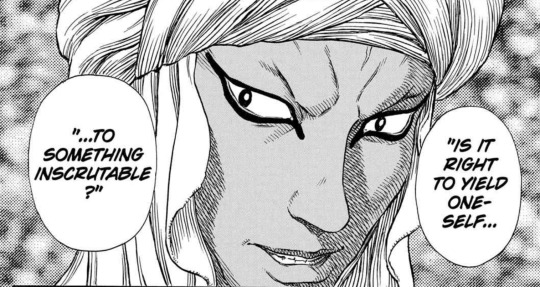
This is an aside from the series of meta analysis that I am writing about Berserk. I really didn’t expect to like this manga at first, let alone wanting so much to understand what I felt I wasn’t able to grasp behind the surface level. Years ago when I first approached it, I was actually quite unimpressed by the first chapter.
I should add: the first Italian edition was unfortunately flipped and I really disliked that choice back then. Some other series at that time (late 1990s) had started to be published in their original format and I didn’t find it difficult to adapt my reading habits to the original layout from right to left. Reversing the artwork in a manga like Berserk? I am sorry but that was criminal. Not only the characters would have their swords in their left hand but the mirror effect could seriously affect the energy of the line work and the overall harmony of the panels. Big scenes with a battle on horseback flipped? I couldn’t really get over it. Another manga, maybe? But Berserk? Art and composition are such a huge aspect of it, I didn’t love to have to compromise. The last two editions eventually came out with the original right to left flow, but also so much more expensive, it is a crime of another kind. So that is how I came to read the English version. Gatsu became Guts (I don’t know about that because now I think about the meaning of the word in English and I don’t particularly like it). Grifis became Griffith. Falcons became hawks.
So, I wasn’t impressed by the first chapter, definitely discouraged by the flipped artwork and annoyed by… Puck! I must say, I never really liked fantasy as a genre, especially because it uses creatures and I didn’t know what to make of this elf that contrasted so much in mood with the main character. I grew up reading a lot of novels that were considered classics in my culture and that was a great number of nineteenth century literary realism, French and Russian novels and Italian historical and realist novels from the nineteenth and the twentieth century. And literary realism was born from dissatisfaction with the irrational forces and themes of romantic and gothic narratives, aiming to look at the human experience directly and in an unfiltered way. I still prefer stories that are like that and the dark and gritty side of Berserk makes up for the fantasy aspects and what is more, Berserk seems to have the goal to criticize the irrational forces it represents rather than idealize them. And I am also quite comfortable when love is a thing but it isn’t framed under the romantic lens, that aren’t universal but quite culturally specific and distinctive.
Guts also wasn’t exactly an exciting main character for me at the beginning, it really was easy to mistake him for Kenshiro from Hokuto no Ken. Which I didn’t have anything against, that anime had such a good title track in its Italian adaptation, and the general desolate atmosphere was fascinating, although I watched it when I was too young to actually consider the story, I only remember the vibes. But I have never been into brooding, stoic and exaggeratedly burly men or 1980s action heroes. Reading further and I was very relieved that Guts wasn’t one of those.
Maybe Berserk wouldn’t have been back in my radar if it hadn’t been for the Souls games, new editions and anime adaptations coming out and in the end Miura’s own passing. So I started reading it again or for the first time in its digital version, completing it up to the current chapters. Reading it now that I am older definitely makes it easier to understand the scope of it and appreciate it. I think that Miura was definitely an ambitious man. His hands were exceptional, although I mourned the unpolished look of the paper and ink when he made the decision to move to digital drawing. Same hands but different surface, different way of absorbing the effort of those hands and the disappearance of the materials into numbers. There are volumes in the middle of Berserk that are just glorious for me, artistically, better than the first ones because the artist was practicing to the point of overworking and becoming incredibly good, better than the last volumes when he chose the hard support of the drawing tablet and the passages between lines and white could only be neater than what it used to be.
When analyzing it, one thing that I found impressive is how cohesive the story feels in its themes considering that it started in 1988 and that continues on under such unique circumstances: Miura and Mori’s relationship being fascinating in itself, in relation to the creation of Guts and Griffith’s dynamic. Berserk started to be published more than three decades ago. I want to point out how difficult can be to begin a story in your twenties, seeing it published monthly as you are likely working with only general ideas of where you want it to go and as you grow older. The editing was minimal. I would like to have more information on this point but I don’t think it was a big concern for a manga being published in Young Animal for Hakusensha of all places. As I often say in this blog, context matters and, although most people read and approach Berserk in its paperback or bunkobon format, all its chapters have been published first in a magazine that is primarily intended for young male readers attracted by photos of gravure idols on the cover and that expected to see erotic scenes, violence and maybe would also get into a story deeper and maintain the interest as long as those elements were there. Nothing wrong with that in my opinion, especially because many beloved novels that are considered classics were originally published periodically as well. And Miura’s approach to the erotic and violence doesn’t feel gratuitous when you think of the story in its entirety and complexities. In the history of art that I am familiar with the human body has always occupied such a central role and themes similar to those of Berserk are frequent and this is probably another big reason why my interest has been picked. It is familiar and not. I am careful about context! It’s manga, not chivalric romance, it’s a contemporary and commercial mixed form of art and not fresco paintings depicting stories on the walls of aristocratic houses, the author is Japanese and not oblivious to a great deal of European and western culture but is also much more immersed in his own culture and using the Japanese language. Kanji on a manga page or beside any drawing aren’t just words, but they are also synthesis of other images as well and images/sounds/concepts that add a lot to the art, most of it lost in a translation. And frankly, my major pet peeve is that the western fandom sometimes doesn’t really understand that the recognizable forms and themes of Christianity and heresies are seen and used from the outside and from a point of view that doesn’t ignore a whole lot of other religious traditions. And other religions have much more influence on certain themes presented in Berserk: suffering or rebirth mainly are two big themes at risk of being acritically absorbed from a Christological perspective that to me personally doesn’t feel right if we keep in mind the overall context of Berserk as a work of fiction and as a manga.
The only major edit that Miura was able to make when Berserk was published in volumes was the removal of chapter 83. If we consider the conditions in which Miura worked, for the first years it would have been very risky to even consider taking a hiatus, I would assume that he didn’t have much time to even make changes or adjustments in his work. But the removal of chapter 83 is interesting. Having been published in the magazine, even when it is missing from current publications, copies are around and available to see. That chapter, that comes before the Conviction arc, was removed because, rumors say, Miura thought it would have given away too much. I think that chapter 83 made Berserk’s Gnostic point of view too overt. Not surprising considering Miura took a lot of inspiration from Go Nagai’s particular brand of religious syncretism and that Gnosticism was frequently discussed in the 1970s and 1980s and probably still is.
I am not an expert on religious studies, I have a very superficial knowledge of just about anything related to religions. I am actually an atheist myself, if anything it is maybe easier for me to understand when an artist operates from an outside point of view rather than from inside a particular faith. Through art and music especially, and thorough words and practices used maybe carelessly, I am not completely ignorant of a plurality of religious beliefs. I might not approach the topic from a believer’s perspective nor for personal spiritual needs, but I am interested in it because of intellectual curiosity and interest in humanity. I don’t position myself above or below, just outside religion. I know I’ll never have enough time or intelligence to even know enough of a single interpretation of one major religious tradition, let alone severals. From a complete superficial perspective, I can only sense and try to understand Miura’s approach to those themes. I am able sometimes to recognize the sources and influences that colored his views on certain topics. I wouldn’t remember enough about Gnosticism from what little I studied in school many years ago, and I wouldn’t have any idea about the occult and many forms of religious syncretism if it wasn’t for having listened to a lot of rock music and being immersed into the popular culture that surrounded it, including manga. Same thing I can say about Nietzsche’s philosophy. I studied a little bit of German philosophy in high school, part of the standard curriculum, and I read on my own The Birth of Tragedy Out of the Spirit of Music when I was sixteen. Young Nietzsche, younger me. I can’t say I remember much besides the highlights of his philosophy. But then I became more and more intimate with David Bowie, his particular approach to music and art and how those things interact with society. Believe me or not, David Bowie is probably my favorite critic and commentator of Nietzsche, even when he didn’t do it through academic writing, but through his music, his own life and artistic outputs. And I love that. This is why I love Berserk too. Maybe because Bowie and Miura were artists whose work became vastly popular, they are easily misunderstood or considered to not belong in the same category of academic discourse about Nietschean philosophy, and just approached superficially, yet they were much more likely to discover the fallacies because they looked into it from a human experience, Bowie through himself and embodying his characters and Miura through drawing and voicing them. To me they actually managed to get rid of pedantic attitudes that keep people away from useful forms of philosophical criticism and learning. But it is entirely possible that I am just not smart enough and Miura’s moods and approach agree with my general worldview and I am indulging myself here.
Why am I writing all this? In part I am probably stalling. I keep postponing the moment I’ll have to write about the central theme that most fascinated me in Berserk, but it is also the more painful aspect: Griffith’s self delusion and the numerous other instances of illusions and mirages that humans don’t have the strength to resist. I haven’t even talked about Farnese or the Lost Children chapters for the same reason. It is daunting to put my thoughts into words intelligently and in a way comprehensible to others (hopefully). But that’s why I started this series of meta. And I am writing my analysis on tumblr because I rather be in the company of those appreciating and analyzing the queer and sentimental aspects of this manga, but I also think that the “romantic” element is a part of it but not exactly central to the story. I think that under those lenses alone the manga would just be quite imbalanced, bad and definitely tragic, less interesting or remarkable to me. Love is a major theme but I don’t think it’s developed through the romantic tradition intended as a cultural invention. When Miura drew and wrote about love, he wrote about the immense difficulty of it on many levels, including the familiar one, the lack or withholding of it from parental figures, the abuse of the spontaneous love of children, the fear of being vulnerable and connecting with others, the desire of intimacy and the dark side of it, the impulse to leave relationships and abandon people behind. I have the impression that through this story, I can see another side to my own experiences. Is society pushing young men to believe that they have to do everything alone, knowing that they can’t succeed, while is telling women that they can’t do anything by themselves, knowing that they won’t be welcomed? Why are we being bullied and forced apart, divided into bullshit categories and separate worlds when we would be better facing the hardships of life with as many allies as we are able to keep? Not alone and not exclusively through a romantic dimension or sexual favors or money deals. Why are we following blindly teachings that have already been proven false and so damaging? What price do we pay for not following the rules?
#berserk#berserk meta#general considerations about Miura’s art#background and other thoughts#eri reads berserk#manga analysis
14 notes
·
View notes
Text
Claymore review

7.8/10
An extremely overlooked cult classic. It's probably the butch lesbian fantasy of all time.
For a good time for the most part I still think everyone should read it!
The Anime
this is probably the first time ive preffered watching the anime than the manga. Personally i found the beginning of the manga drawn too plain and thought the story telling was illustrated in a rather boring way and honestly i dont think the Norihiro Yagi was at the level he needed to be with choreographing fight scenes in a comprehensive way at the time and i just had to go ahead and watch the anime instead mostly because i could finally understand what was happening in scenes.
I really liked the anime however in the i am always inevitably a manga over the anime fan til the bitter end. It actually made me really angry to find out they had to drastically change a bunch of major plot elements and even make up a bunch of shit just so they could wrap up the anime in a nice way. Like i kind of understand why but it was actually such a corny and confusing ending it actually made me really angry lmao (ESPECIALLY HOW THEY REPLACED THE SCENE WITH JEAN SAVING CLARE WITH RAKI INSTEAD)
The Characters
For the most part I really liked everyone but of course I absolutely despised Raki. I do not blame anyone who couldnt bring themselves to continue or even start the series because of him because it took so much out of me to continue regardless of his almost pointless presence.
Like I kind of understand its because hes sort of supposed to expose and ground Claire's humanity but i really think it was still possible to do that without him even existing. hes kind of really a walking character device isnt he? Like im pretty sure Jean's existence was enough.
So anyways i think everyone else was really cool.
setting/genre/lore
I really dont know how to start with how much i admired everything. I really liked the legion of really cool/scary/pretty butch lesbian warriors, the concept of youma/awakened beings is so interesting and i love how horrifyingly beautiful they all are, I was super into how little i fucking knew about the organization.
In general everything is so unique and fresh I like everything about it. It pains me to no avail acknowledging that this is the only series asides from berserk thats a dark fantasy and even worse understanding both of them are technically over and its extremely maddening knowing nobody wants to draw dark fantasy manga anymore
creature design
i fucking love monsters so of course I have to discuss the unique appeal of the creature design in this series. One of the greatest things i absolutely adore from Yagis designs for the awakened beings is the stark contrast of a creature that is frightfully elegant.
I have to praise Yagi for also being the only other artist asides from Kentaro Miura whos considerate about exploring different shapes and forms for the overall silhouette of his creature designs.
Another specific aspect I greatly admire from his designs is that hes probably the first artist ive come across whos capable of mixing mostly scaled/armorlike textures on a monster while still retaining an air of tension and an organic looking design.
from my own personal art and observation from other creature designs from all sorts of artists I find it almost impossible to have these textures while retaining said elements of design because i think it gives it more of a "cool" vibe than a scary one.
Up until this point I was quite convinced its only feasible to have scales/armor-like textures on a monster if you balance it with a fleshy texture (approximately 70-80% fleshy and hard textured for the 20-30%) but Yagi truly is a genius or something because hes the only artist i know whos capable of making designs that are like 90% armor but its still somehow gives you chills.
So anyways heres a list breaking down my deepest feelings about my favorite awakened being designs:
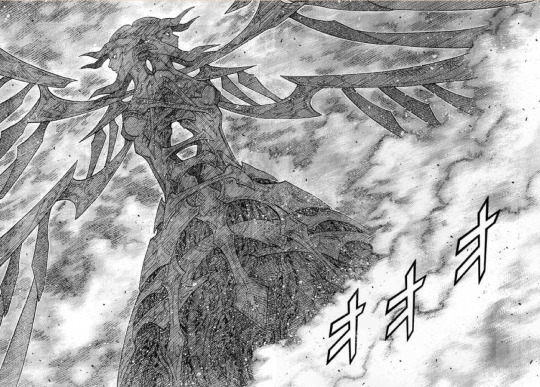
1. The destroyer
I actually havent ever seen a monster design so grand it took my breath away. Theres too much to love about it. Out of all the awakened beings nothing radiates such a thick aura of radiance and absolute terror than this design alone.
The whole idea of two sisters lovingly trapped together to become a greater and unstoppable creature is so overwhelming it really makes me shiver with delight and terror. Ive never felt so strongly about a design before so I really think nothing else will outdo this unique sensation.
Its just so fucking cool!!!!!!! I'm obsessed with religious iconography so i really adored how it was shaped like an angel and devil at the same time. i thought it was super fascinating how it would relentlessly and indiscriminately shoot everything and everyone in its radius with pieces of itself warped into more awful abyssal creatures that could even manipulate and transform anyone it stabs itself into. its all just so coollllllllllllllllll!!!!!!!!

2: Isley
i thought isley was a really weird guy and i probably hated him but i cannot deny how I think his awakened form was soooo cool. Isley is the prime example of what i was talking about with balancing textures on a monster. Super cool design i like it a lot
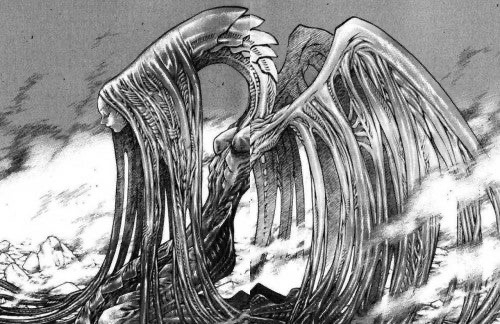
3: the awakened girl that showed up during ophelias first appearance
god i really wish i could properly admire her with knowing her fucking name. Quite an ephemeral appearance but she had such a unique look to her despite everything I've seen throughout the series i could never forget her. She's probably the defines the general features and theme of what awakened beings should look like. A trend setter dare i say.

4: Cassandra
VERY interesting silhouette. its not often you get to see a humanoid like body be treated like somewhat of a quadruped. Its interesting how its something vaguely erotic and terrifying at the same time. The multiple heada that snaps its jaws on anything that gets near it is a fantastic touch.
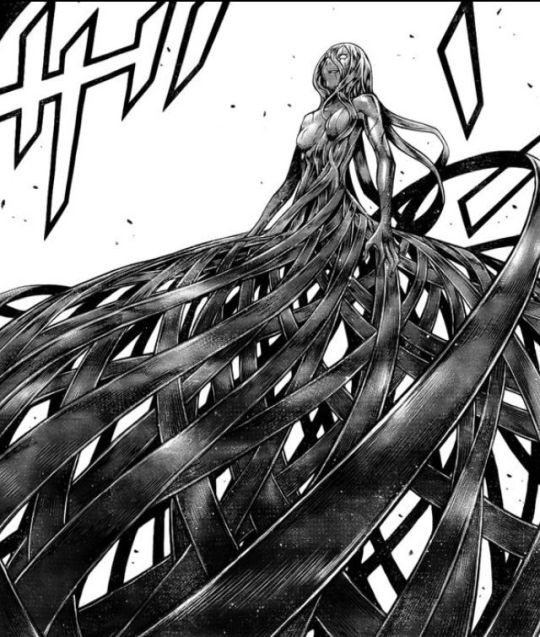
5: Riful
overall a relatively simple design but its the simple things that are always the most fascinating isnt it? I really like tangled looking monsters. Not much to say except slay honestly lmao
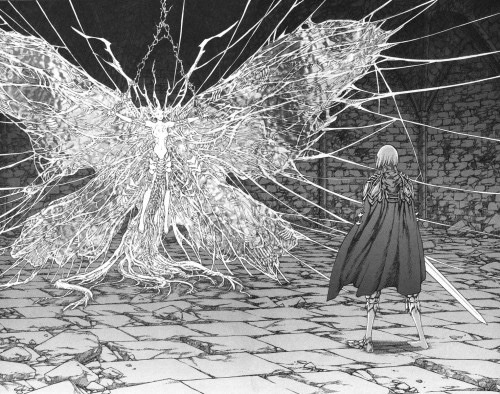
6: Jean
She was only in this form for such a brief moment but it was such a striking design I couldn't forget it. If find the most unforgettable things are usually the most fascinating things in turn. Such a gorgeous yet terrifying thing. I hope i dont sound like a psychopath saying this but the visible helplessness being trapped in an awful and radiant body is very beautiful to me.

7: Miata
quite a short appearance but i really liked the silhouette of her awakened form. I wish there were more panels showing more closer details of it. not much to say about this other than i think its really neat!
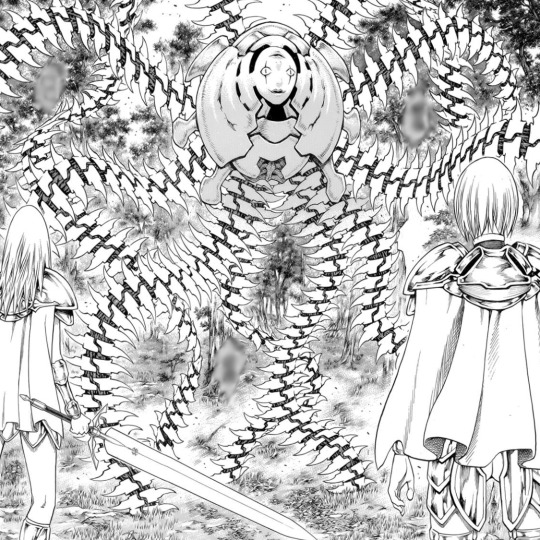
8: europa
literally just a ball with several spines attached to it and i could say its a bit lazy in comparison to everyone else but theres sm attention to the finer details of the spines i cant get mad at it. I know you're supposed to focus on the arms with this design but i actually like this design the most for just the face. The upside down doubled face is really interesting to me and i admire it a lot for some reason.

9: the abyssal eaters
probably one of the most terrifying creatures in the whole series and maybe somewhere up there in my hierarchy of the most scariest monsters in a manga. i LOVE LOVE LOVE the whole idea of them so much bc theyre so fucking scary!!!!!! Very simple design but i never get to see stitches ENOUGH in media (which is a huge shame because its one of my favorite features to draw with body horror) so it makes me happy that all of their faces is just stitches.
THE STORY and the series as a whole
i really wish i could say i loved everything about it but everything I loved about it in the beginning basically disipated in the end. I think the main issue lies in the fact it all started in a very simple but effective manner but yagi ended up over complicating everything by adding too much. I don't scorn Yagi at all for the almost sudden and utter collapse in quality writing because its sort of an inevitability with titles that go on for a very long time. But I still think it's important and valid to explain my fascination with it in the first place.
I really liked the overall simplicity it had with everything. The plot at the start was very simple and straightforward: a woman who gives up her humanity to avenge the death of her only family. Not a unique plot of course but it obviously was the main character herself and companions (excluding raki ofc lmao) who really makes up the story.
I really liked how Claire was never the strongest. She really appeared to be but comparatively speaking to her fellow warriors she pales immensely. And I think its that remaining humanity I really liked the most about Claire. I REALLY liked how cohesive her group was and I was so impressed with the storytelling and character building in the beginning because at the time I thought this was the only other series I like I could think of other than Dorohedoro where theres a lot of characters that show up but you actually manage to sincerely remember them because they all have meaning. Too many times i run into series who introduce too many characters solely just to keep the story fresh; but none of them have any real purpose to them.
I also was obsessed with how well Yagi was with building tension throughout the story. To me I think its really hard to find series who are able to capture their readers with a good sense of tension.
The characters in this series are quite overpowered, but In the beginning I found it extremely admirable how Yagi was still able to make the reader feel anxious about whether or not the protagonist or their companions would persevere againt their adversaries. Yagi had a very good sense at balancing everyones strengths and flaws in a very balanced way.
But again with the sands of time it couldn't stay this good forever. To be completely honest it took a lot out of me to read the rest of it. It came to the point where i was so lost and frusturated about how confusing everything got i was just trying to read it just so i could be done with it?
I think my main problem with the series as it ended was how unfocussed it got with the plot. I feel like everything immediately got so muddled after the fight with Rigardo. Maybe it's just me but I honestly was ok with never understanding the organization I was mostly just interested in what was going to happen with the main cast with the abyssal ones and such. It actually made me really angry how the battle scenes got so stupid overtime with how it became one of those series where they overexplain the characters' tactics for a very long time. I initially really liked the battle scenes because they dont talk too much and they just simply fight, i really really hate it when anime/manga does the latter actually.
I don't really know how i feel about the ending honestly. I don't know if im satisfied with how claire somehow turned into teresa and she killed priscilla instead but i guess it was nice? I don't know how i thought it was all going to end but i would have never expected it to be like this and i dont say that in a good way but more of a confused way if anything. I wouldn't say it was a bad ending? but I guess thats okay???
anyways, despite all my criticisms i still think its worth the read and the credit it deserves in the end. It's really weird how it went on for so long but no one ever seemed to care? that makes me quite upset actually.
9 notes
·
View notes
Text
In writing this on September 8, 2021, news has spread about the likelihood of chapter 364 of Berserk being the last. This news may change. I’m not sure how to feel about that, in either case, continuing, ending, of a hybrid of both (something like an art book with an outline of the story direction, perhaps).
I’ve heard plenty of opinions about what should happen.
The only answer is, of course, what Miura would have wanted.
I don’t know if we have that information. I hope that this information will be released with the chapter, but I write this in consideration of all creative-types, and those who go forward with projects: as part of our death preparation, we should make it clear whether or not we want our works to continue after us, and if possible, who we want to continue them, or if it is a general thing.
One series that comes to mind that continued after the death of the author is the Oz series, originally by Frank Baum, and continued by many authors ever after. I believe it was Baum’s intent that it continue, after he was talked into writing sequels for it himself, because it pleased children – and that was enough for him.
A series that ended with its creator was Suite française by Irène Némirovsky, who unfortunately passed before the series could be finished due to the holocaust.
And then, we have the odd compilations, such as The Silmarillion, which draws together the pieces of Middle Earth, some narrations and edits, but not a huge, cohesive, novelization of it all. Just the remnants and scraps of what was left by Tolkien.
It makes me consider what I would want done with all my half-finished projects. Quite honestly, I’d rather they never see the light of day, though if I ever were to get published? If I had a series that was going forward?
In that case, I think I would opt for a compilation of sorts. Something to tell people how it ended, what details I may have planned, but little else. Let fanfiction handle the rest! Perhaps it could be finished in a TV series, or film, but I think I’d also rather leave that hanging, too. Seeing the mess that was Game of Thrones has turned me off to bad endings.
So I wonder – is this what Miura would prefer?
Is this what people prefer?
I know we all have different opinions and different preferences. Some people would prefer it be finished, no matter how haphazardly. Some would prefer their notes burn, because they were unedited and unprepared for the light of publication. Leave things as they are.
No matter what, one thing is certain: on endings such as these, the imagination will always strive to fill in the blanks. Even if we are given an ending, we will wonder if it would have been different, had the originator been authoring it.
So before you die, remember your projects, and remember to delegate it, so everyone knows your wishes.
And hope that your works can inspire, even unfinished.
Miura did enough, and still I hope his thoughts were at peace at the end, and not fretful over unfinished things.
Forever, my gratitude for so much that I love, goes to Miura.
3 notes
·
View notes
Text
On Worlds.
We inhabit them. We've christened ours Earth, but there are some who call Middle-Earth their home. I've heard many dashing tales from the Borderlands, and on all too many occasions guested in Azeroth. All these faraway lands are unique in their own right, sporting flora and fauna so diverse it really does make one wonder how such things came to be, whether out of nothing, or out of the wilds of human imagination.
I've always been under the impression that it would take a person too much blood, sweat and tears to fashion one. But here I stand, alone, and I need a place to set my latest overambitious and never-ending enterprise. It's a habit I'd always detested deep down, but came to respect over time, and now I say it is the prospect of making something grand, chipping away at it day and again, that gives me one more reason (among many, mind you) to get up early in the morning, and wonder what aspect of it am I going to work on next.
So it is, that I've been pondering on the sort of a world I would want you, the Player, to quench your wanderlust, and perhaps take your subconscious somewhere it has never travelled.
My research -- that hunt for inspiration, artistically speaking -- took me to media I have and have never ever witnessed, or heard, or read, or seen. I've browsed art, played this game and that; I've watched film and series, and I've brushed the dust off some of my forlorn literature. I've even dared to show up in the local library for once in an embarrassingly long (by a reader's standards) while, and borrow a "manuscript" or two I thought had a few interesting ideas. But, I have to admit, Stack Exchange remains my personal favourite. There are so many great minds there, with an equal knack for world-building, and even more thought-provoking questions granted inspiring answers. I can't recommend it enough.
On to the point, though, and it is that I've compiled a list of "archetypes" to take into consideration building my own world:
Earth-likes
What a surprise, huh? I believe it to be the most widespread archetype, and it is rather self-explanatory. An Earth-like world is more often than not a carbon copy of the blue planet (or our rather milky galaxy), with oceans and continents shuffled a notch to dodge the cosmic copyright, so to speak. It is again most common, and for a good reason: we know plenty about the science that keeps such worlds (and, by extension, our own) spinning, and the life living the way it does. It is a solid point of reference, backed with facts and studies so easy to look up on the web, or anywhere bookish, and it is always oh so tempting to use.
A few notorious examples taken from modern authors include...
...a continent under the influence of Celtic and Germanic myths; known as Middle-Earth of J. R. R. Tolkien.
...the super-continent of Stillness by Nora K. Jemisin.
...the Present World, to some extent a mirror of ours, and found in Kentaro Miura's Berserk.
...or the unforgiving deserts of Arrakis, credited to Frank Herbert.
...or Faerun, the iconic setting of Forgotten Realms.
...or even the Journey, courtesy of thatgamecompany, and the dunes one has to slide down rushing to the mountain's peak.
If at least two of the above ring a bell, you may have an idea of what brings all these worlds together, and by extension, what I think constitutes an Earth-like world. If not, then let me illustrate my point instead:
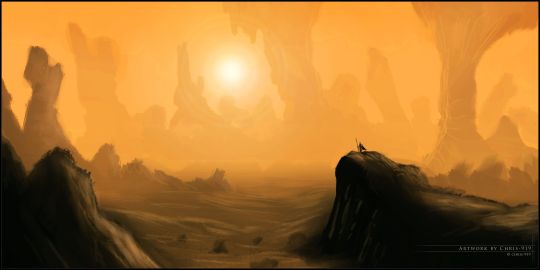
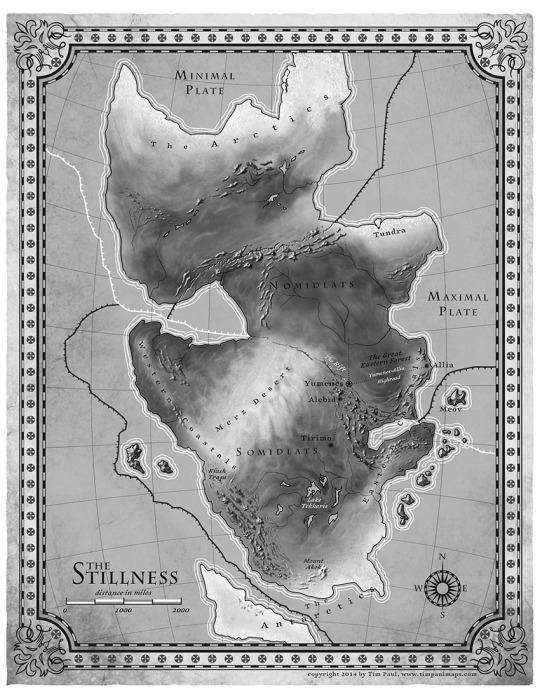
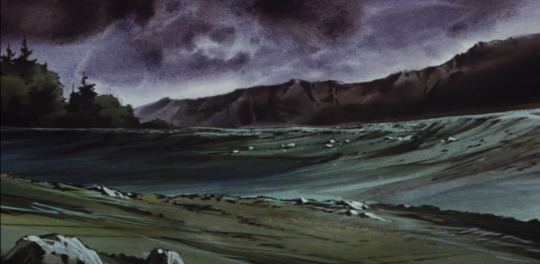
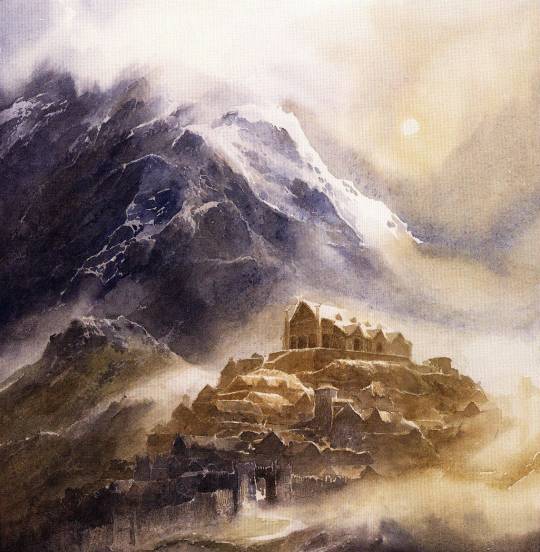
Go on, draw a comparison! It wouldn't take a particularly perceptive eye to notice that even a seemingly outlandish example, the desert planet of Arrakis, shines features not too unlike those we may find here on Earth, albeit "turned up to eleven," for the lack of a better expression. They are planets filled with oceans, and continents in between the oceans, most of them, and in general they follow the same rules we follow in our universe: desert storms rise as the wind blows, plates collide to erect mountains, and sentient life is soon to usher in an age of civilisation. Physics and passage of time progress the world as you would expect them to.
Naturally, there will be a degree of variation between Earth-likes. George Martin's Westeros, for one, is an otherwise conventional continent subject to unconventional seasons, some so abnormal they shape entire cultures -- consider the Long Night, for instance, and the impact it had on the Westerosi folklore.
Let's touch on Arrakis again: it is too an Earth-like world at the core, that suffered from a speculated misfortune of a near-miss encounter with a comet, and what once might have been an arid and bountiful world has now been left a scorching desert inhabited by massive sandworms that have evolved to swim through the sands as though they were oceans, and gobble up the teeny-tiny human wanderers crossing their "soil." A few similar worlds come to mind: Kharak, just as extreme and featured in the Homeworld series, and the much more famous Tatooine, the brainchild of George Lucas.
This big quirk -- extreme weather, unpredictable seasons, or morphed geology, or fictional species -- I prefer to dub "the Twist." It is something, a phenomenon or fact of life, that sets this world apart from ours -- something you can use to suggest that the world at hand is its own, and not Earth put in an alternate reality. Extreme biomes of Arrakis or Kharak, and bizarre seasons of Westeros, are just two examples of the Twist. Magic and magical beings found on Azeroth, or in Faerun, is another.
While the Twist is found in all archetypes, I'm of the opinion that Earth-likes depend on it more than others. Take away the Twist, and you will be left with yet another exoplanet, abiding by the rules we all know and, to be frank, find them too mundane to entertain us, or to leave a lasting memory.
As you'd expect, this was the first archetype I visited and considered for my game. The Twist I wish to feature, to go hand in hand with game mechanics I have devised, is the marriage (or clash, depending on your point of view) of science and magic, and the many ways cultures practicing either-or-both would balance them out, or tip the scales in one's favour if they so desire. I'm also very keen on endangering the Player on their journey, which I want to be perilous, and for it to matter more than the destination. Think of it as a world of vagabonds and gallivants, travelling from one bizarre place to a place twice as otherworldly, and embarking on life-threatening quests.
I've considered several worlds, most notably Kharak -- whose native species, the Kushan, traverse it on trucks and jeeps and other sand-crawling machinery. Cities on that scorched planet exist as only safe havens around, surrounded with lifeless sands, and to make it from one city to another is a dangerous affair indeed. The theme resonated with me quite a bit, but I did not find desert planets a good choice for my game, for many reasons:
It is, as the name suggests, a giant desert. There aren't that many biomes (just two, in fact, if you count largely mechanical cities as one) for the Player to explore, and there is little challenge in generating them on the fly, as opposed to a more varied world.
Throwing in arid biomes we discover in worlds like Middle-Earth or Narnia, or Faerun, felt far too conventional to me, and in my mind there would not be much room for an apocalyptic event so crippling as to make exploring this world nigh fatal.
Even if I dodged the desert altogether and rolled with a different biome or biomes, I'd still have to balance between two problems I doubt are easy to solve: featuring more biodiversity in a fundamentally monolithic environment, or more extremes in an Earth-like world that would not fit in very well.
Banality. Banality was a major concern for me, as there are oh so, so many Earth-likes out there in the industry, and the last thing I wish for my little side project is to offer yet another one. No sir!
Scope was the last but nevertheless just as important. It is difficult to fill up a giant continent, or continentS, with enough quests and points of interest to keep the Player invested. It is hard enough to produce enough scripted content, a la World of Warcraft, and it is harder still to delegate the creative matters to an automaton (Talking about you, Left 4 Dead!). Earth-likes, to my understanding, necessitate imposing scale, that I can not hope to achieve neither alone nor in company.
So I scratched this archetype off my list, and again I went searching every nook and cranny of the game industry and beyond for patterns and clues to make into archetype...
Otherlands
Perhaps not the best title to describe a world so otherworldly as to defy all laws native to our universe, but I nonetheless thought it described what I had in mind for such worlds best. Exotics, Otherlands, Alternate Realities, you name it: they spit on the natural laws we've always known, and turn what we consider to be natural upside down, from a relative point of view (I'd image they'd think we earthlings bend their ideas of what is natural, vice versa). They more often than not have so little in common with a conventional; continental world, that as a Player, you ought to be born anew, in a sense, as you have to come to terms with the new reality, and learn the rules alien to your human brain-box.
While not so abundant in fiction or film, there is an unexpected plethora of otherworldly examples found in video games. I suspect, as little more than a humble writer and not at all a qualified game designer, that the blame (the reason, rather) is at least in part to be pinned on the freedom of mechanics worlds detached from all physical boundaries allow. You're no longer on Earth; seldom even in our universe, and more often in a dimension forged by game designers to fulfill a very blunt purpose: to serve the gameplay, in full. I'd imagine it is times easier to set a game built on mechanics hostile to laws of physics somewhere abstract; mallable, in a way, to the designer's whim.
Thinking of examples took me to these fine pieces of digital entertainment:
William Chyr's Manifold Garden is, to me, a quintessential Otherland. It is set in an abstract world wrapping on itself, juxtaposing impossible geometry against Euclidean space. About the only link to our reality it maintains is the presence of gravity. Look up and down, try interacting with the objects or solving the puzzles, and you will very soon understand this is NOT the realm accomodative of your earthly instincts.
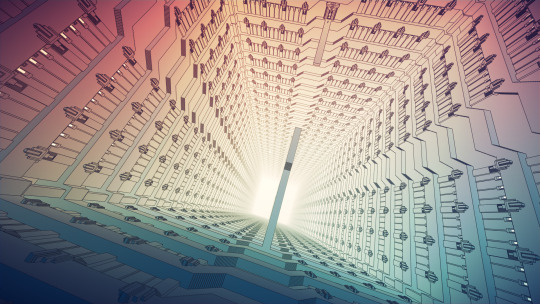
Alice: Madness Returns, too, features an Otherland (not Otherlands, fellow Alice fans!), a level set among the clouds, far above in the sky -- none other than Cardbridge! Playing cards dwell there, and glide along the windy streams to form marvellous paper castles in the sky, and bridges, and gates for Alice to cross on her way to the evil (is she really?) Queen's heartful (quite literally) domain. Like in Manifold Garden, physics still permeates this world, but the only "actor" it appears to affect is Alice herself. All that surrounds her, on the other hand, behaves in a way we would think odd.
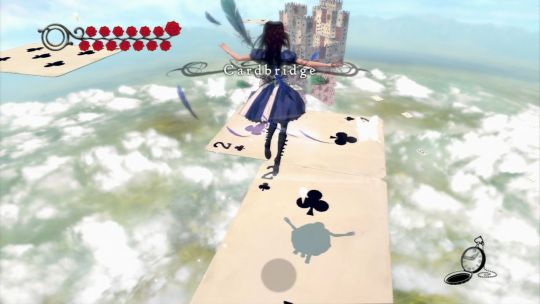
Oddly enough, Valve's Ricochet is one more example of an Otherland, the way I see it. It's set in a pitch black void, a pocket dimension of a sort, and constricts its gunslinging inhabitants to a small archipelago of quasi-futuristic-looking platforms. It is in many ways abstract and disconnected from what we would brand a "real" world; akin more to a simulation than something even an advanced civilisation would be able to orchestrate in the vacuum of deep space. It instead serves a solitary purpose: to be an open and clear arena for the Players to pull off dextereous ricochets and physics-bending leaps from one spot to the next. There are no other earthly rules to govern this world, and beyond the dark arena is the thrice as dark abyss.
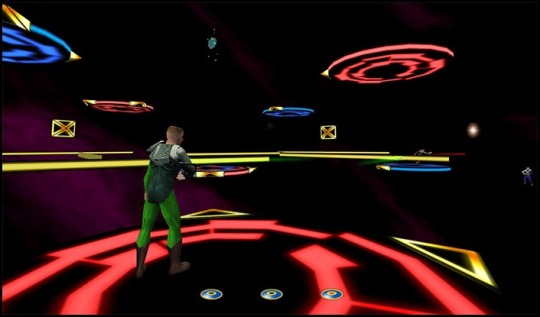
Of course, by this logic, one could consider more abstract games along the lines of Tetris Effect or even Pinball Dreams, to also fit under the same umbrella of otherworldness, and I reckon they would be right. Both games take place in places foreign to our expectation for a, dare I say, traditional setting. This is not to say, oh no, that Otherlands belong to just the games -- far from it! Otherlands are to be found in many other media.
Off the top of my head, I'd count that one scene from the cult-classic 2001: A Space Odyssey, as a "classic" Otherland in a mind-boggling nutshell:
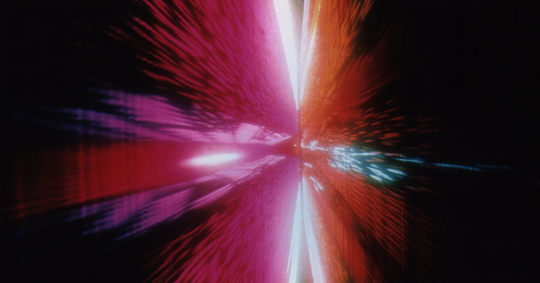
The message I'm trying to convey, if not clear, is that Otherlands are very stubborn, and insistent on breaking you as an earthly thinker; to augment your mind and let it comprehend and utilise the new reality and the rules it enforces, like one would use the laws of our universe. "When in Rome," is the mantra they will have you etch into memory, until you think and interact with it as though you had never known another home.
The entire world, in other words, is one big Twist, standing in stark contrast to the little twists applied here and there to an Earth-like dimension. Furthermore, one could even assert that the Twist in an Otherland is turned on its head -- whereas in an Earth-like Twists were other-landish phenomena many in number but little in scope -- the Twists in an Otherland are instead few and far between, and grounded in reality. They are the links linking an Otherland to the Earth-like law. Say, physics would be very much expected in an Earth-like world, but treated as an exotic Twist in an Otherland.
To be a little more precise, an Otherland does not bother to stay true to the mechanics we think mundane and natural. It instead moulds or kills them outright, and throws itself at the mercy of the designer's wants and wishes.
Otherlands were an option, but not the option, that I'd choose for my world. I cherish the freedom they bestow upon you as a designer, but it alone did not convince me to opt for this archetype. Simply put, the downs outweighed the ups:
The world I wish to create will host fantasy far too Tolkien-esque to distance so much from Earth and earthly law. There is, in my view, a strong pull among many dungeon-crawling aficionados towards fantasy, and fantasy I will deliver. My own strain of fantasy, to be clear, but it will nevertheless mandate a degree of reality deemed by me too Earth-like to belong in an Otherland. I just can not see, at this time, a world of fantasy that is also an Otherland, not if I want my world to radiate welcoming familiarity.
This game being an open-ended RPG, it is difficult for me to envision it in an abstract environment. It calls, as I see it, for landmarks sensible to someone never ever "tainted" by the quirks of Otherlands, familiar and homely in a way, based in laws of physics and around points of interest grounded in our reality. Elevating it to be the Twist of an Otherland, brings the latter much closer to an Earth-like, but not quite. Neither this nor that, if you will, and that in turn leads me to the next and last archetype...
Near-Earths
Should you ever run into the same predicament as yours truly did in the paragraph above, I'd strongly advise you to consider Near-Earths. Not entirely Earth-like, but also too Earth-like to fit as an Otherland, a Near-Earth world is based to some considerable extent in the laws and traits of an Earth-like. It takes the best of both worlds -- mind-boggling Twists of an Otherland and experiential familiarity of an Earth-like -- and mixes them up to shape up something in-between.
Near-Earth remains ultimately an extension of an Earth-like world at its core, but to set itself apart it puts an emphasis on large-scale Twists -- that would be considered too outlandish for an Earth-like. One popular trope among Near-Earths is to feature earthly topology, strewn around the universe in the form of isles or even whole continents. Fundamental laws that define an Earth-like it bends to a fictional degree, but preserves the essentials, such as planets or stars or faimiliar dimensions, that make up our universe. Thus the link between our universe and that lives on, and it's easy for a newcomer to the world to find their way around with little to no hand-holding required.
I can't help but conjure up a few shots from Treasure Planet, which I gather needs no introduction, to illustrate my line of thought. Take one of the more iconic stills from this flawed masterpiece, R.L.S. Legacy docked at the spaceport of Crescentia:
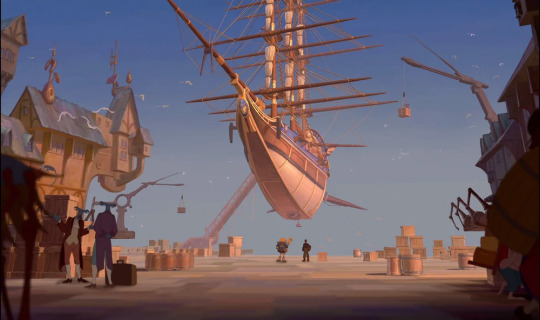
It is in many ways familiar, I think, to anyone who has ever been to any run-of-the-mill harbour, except that ginormous frigate appears to stay suspended mid-air, not even ropes to hold it in place, and not at all swaying side to side on the high seas as one would assume. No, in this universe carpenters and shipwrigts build 18th century vessels propelled by internal combustion engines to fly through the breathable expanse that they call Ethereum. Indeed, there it is possible to breathe in space, so long as one stays careful not to lean too much on the taffrail and fall into the Ethereum proper, doomed forever to be a cosmic castaway.
Treasure Planet is very representative of a Near-Earth world, as I reckon the aforementioned scene proves. While grounded in culture and (partly) science of our universe, it strays a lot from what our scientists would deem feasible, to the point that it is fundamentally different from our universe in some respect, such as there existing a breatheable atmosphere everywhere in their universe, but not so fundamental as to defy every law of science we know in our world. Physics, and planets, and other celestial bodies and phenomena still exist there, albeit altered in a variety of ways.
Another such example would the High Wilderness, that we're told to travel aboard a literal locomotive, in the brilliant game and one of my many favourites -- Sunless Skies:
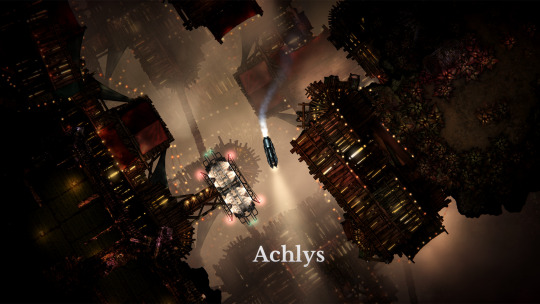
It, too, features all the same biomes and structures and many laws with a basis in our universe, and like Treasure Planet, it introduces a major twist: the space beyond the confines of Earth (which does exist in Sunless Skies, and generally follows our history with significant deviations perpetrated by Masters of the Bazaar) is an intricate maze of seldom interlocked and often overlapping topology, stacked on top of one another, and filled with an atmosphere reminiscent of Ethereum, breathable but named a different name.
It is still familiar enough to us as earthlings, and it would not take a seasoned Otherlander to pick the thing up and know the rules of play by instinct. Sure, we are driving a locomotive through time and space, and pass by living stars that govern all, called the Judgements, but the spaces we traverse and people we meet and phenomena we witness are not confusing in the slightest. Shrouded in mystery, maybe, but ultimately sensisble if given enough thought. There is not another dimension for us to consider, and impossible geometry wrapping on itself to comprehend, as seen in Manifold Garden. Nay.
On the Judgements, as a side note, I've found them to be an interesting twist in and of themselves: they are intended to be the law-makers that decide what is real in this world, and what is not. Kill, or posses them, and the world will return to a chaotic state, easily a contender for the quintessential Otherland.
One last sample for you to taste would be the city-state of Sigil, the center of all planes in the planar world of Planescape (pardon the tautology!). Also an earthly world in many ways, it departs from tradition by dabbling in the ideas of interplanar travel, and whole planes of existence drifting from place to place depending on the belief of its denizens. Name me a single spiral-shaped medieval town suspended miles in the air:

I hope my criteria is now clear, or clear-er, better still if as a day. A Near-Earth has some of its fundamental laws thrown away, or meddled with, but there is always at least some foundation identical to that of an Earth-like.
Enter the Wild
In the end, I had a choice to make; a choice of three options, all of which bore pros and posed cons. Weighing all of them took me several restless nights, about a week in total, and some creative encouragement from a colleague, who suggested I turn to Sunless Skies-esque worlds for inspiration: islands floating in the sky, nurturing islanders and their peculiar settlements. I fell in love with the idea in a heartbeat, and on and on I went searching for references. It implied to me a Near-Earth, and all the marks of distinguishment I outlined before for other archetypes pointed to Near-Earths as the perfect fit for my world.
I settled for a few points of reference, among them...
Variably-sized islands and quasi-continents of Dragon Hungers, complete with pocket cultures and hosts of creatures that dwell there:

"Outdated" and outlandish means of transportation between the islands, like airships or fire-breathing dragons, a la Sunless Skies:
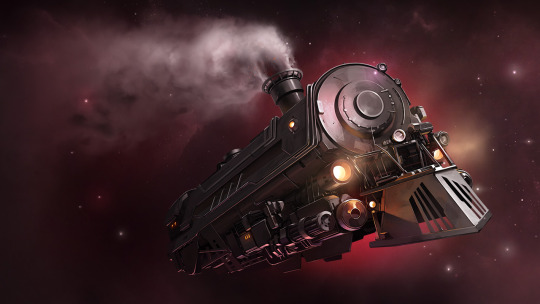
Celestial bodies of Treasure Planet, like black holes or nebulas, making an appearance, though toned down a bit to ditch some of their more destructive and lethal properties. A black hole wouldn't spaghettify you in the blink of an eye, but falling into one will nonetheless bring a swift (albeit not quite so fast and unavoidable) end to your career:
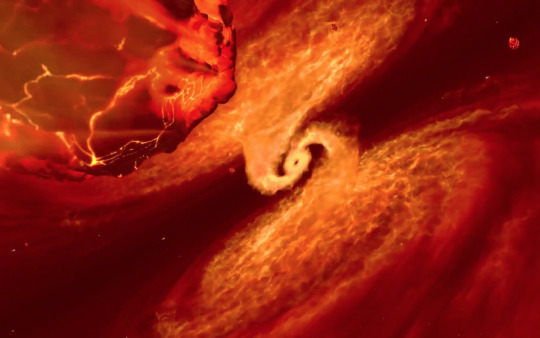
What they amounted to, ultimately, is an amalgamation of varied islands, some as big as a continent, others as small as my balcony, and all sporting ecosystems never-before-seen on most other islands. They are suspended in the sky, fortunate to have a man-friendly atmosphere, with a devilish twist I'd rather keep a secret for the time being.
Wannabe heroes make their living sailing through this sky aboard mighty airships or fire-breathing dragons (among many other means of transportation), from one island and on to the next, undertaking quests and accepting commissions from the locals to earn themselves some sustenance. It's a floating world of vagabonds, gallivanters, and legends-in-the-making.
OR! Those same gallivanters may find a particular island, or spot upon on the island, very tempting to settle on. Indeed, if they so desire, players would be able to adopt a sedentary lifestyle, and see what the wilds beyond the comfort of their heart might bring one treacherously blissful morning...
Us locals have entitled this universe the Wild. Enter at your own risk, traveller, for you may never return. This theme seemed to me like a good middle-ground between all the problems I've outlined reviewing archetypes:
Scope was confined to the typical bounds of an island. Some are bigger than others, no doubt, but all of them are a far cry from the usual dimensions of a continent. A narrow scope, as such, is a scope amiable to developers limited in number, or readiness to tackle an enormous landmass.
Narrowed scope in turn shortens the distance one must travel to leave one point of interest for another. We're feeding two birds with one scone -- there is no need for us, as developers, to fill up the lands betwixt with something for you to do, and you won't have to drag yourself through an overstretchesd piece of half-arsed (pardon my French) filler to finally reach the objective that caught your eye in the first place.
At last, as my colleague pointed out, islands in space are capital. Done before to be sure, that road has been travelled many times (and so were most others), but it is still the Earth-likes that proudly keep at the victorious spree as the dominant archetype among the developers. A Near-Earth to me felt like a fair and much-wanted change of scenery, for once in a blue moon.
A floating world shattered into many habitable pieces by far imposes so many more factors upon the cultures, languages, civilisation, technology, and nature of the wild, that to turn it down in favour of an all-too-researched Earth-like world seemed a lazy way out the massive creative problem, I think, many people of letters and pencil and other trades would be thrilled to approach.
P.S. I do realise all my scribbled judgements are arbitrary, and the lines separating Near-Earth from Earth-likes, from Otherlands, is apparently fine, and entirely subjective. These are little more than my five cents; my five thoughts on the subject, and I personally found grouping these worlds into archetypes a good "bookmark" that I've used and will likely come back to designing my own worlds. Peace.
4 notes
·
View notes
Text
ESSAY: Berserk's Journey of Acceptance Over 30 Years of Fandom
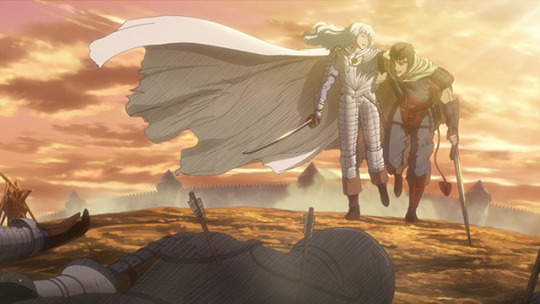
My descent into anime fandom began in the '90s, and just as watching Neon Genesis Evangelion caused my first revelation that cartoons could be art, reading Berserk gave me the same realization about comics. The news of Kentaro Miura’s death, who passed on May 6, has been emotionally complicated for me, as it's the first time a celebrity's death has hit truly close to home. In addition to being the lynchpin for several important personal revelations, Berserk is one of the longest-lasting works I’ve followed and that I must suddenly bid farewell to after existing alongside it for two-thirds of my life.
Berserk is a monolith not only for anime and manga, but also fantasy literature, video games, you name it. It might be one of the single most influential works of the ‘80s — on a level similar to Blade Runner — to a degree where it’s difficult to imagine what the world might look like without it, and the generations of creators the series inspired.
Although not the first, Guts is the prototypical large sword anime boy: Final Fantasy VII's Cloud Strife, Siegfried/Nightmare from Soulcalibur, and Black Clover's Asta are all links in the same chain, with other series like Dark Souls and Claymore taking clear inspiration from Berserk. But even deeper than that, the three-character dynamic between Guts, Griffith, and Casca, the monster designs, the grotesque violence, Miura’s image of hell — all of them can be spotted in countless pieces of media across the globe.
Despite this, it just doesn’t seem like people talk about it very much. For over 20 years, Berserk has stood among the critical pantheon for both anime and manga, but it doesn’t spur conversations in the same way as Neon Genesis Evangelion, Akira, or Dragon Ball Z still do today. Its graphic depictions certainly represent a barrier to entry much higher than even the aforementioned company.
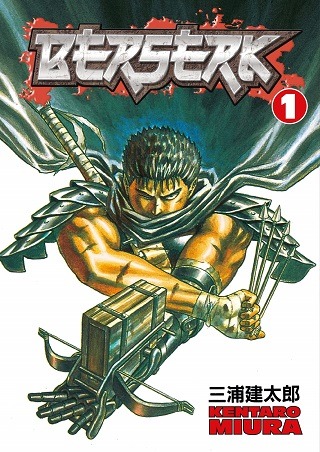
Seeing the internet exude sympathy and fond reminiscing about Berserk was immensely validating and has been my single most therapeutic experience online. Moreso, it reminded me that the fans have always been there. And even looking into it, Berserk is the single best-selling property in the 35-year history of Dark Horse. My feeling is that Berserk just has something about it that reaches deep into you and gets stuck there.
I recall introducing one of my housemates to Berserk a few years ago — a person with all the intelligence and personal drive to both work on cancer research at Stanford while pursuing his own MD and maintaining a level of physical fitness that was frankly unreasonable for the hours that he kept. He was NOT in any way analytical about the media he consumed, but watching him sitting on the floor turning all his considerable willpower and intellect toward delivering an off-the-cuff treatise on how Berserk had so deeply touched him was a sight in itself to behold. His thoughts on the series' portrayal of sex as fundamentally violent leading up to Guts and Casca’s first moment of intimacy in the Golden Age movies was one of the most beautiful sentiments I’d ever heard in reaction to a piece of fiction.
I don’t think I’d ever heard him provide anything but a surface-level take on a piece of media before or since. He was a pretty forthright guy, but the way he just cut into himself and let his feelings pour out onto the floor left me awestruck. The process of reading Berserk can strike emotional chords within you that are tough to untangle. I’ve been writing analysis and experiential pieces related to anime and manga for almost ten years — and interacting with Berserk’s world for almost 30 years — and writing may just be yet another attempt for me to pull my own twisted-up feelings about it apart.
Berserk is one of the most deeply personal works I’ve ever read, both for myself and in my perception of Miura's works. The series' transformation in the past 30 years artistically and thematically is so singular it's difficult to find another work that comes close. The author of Hajime no Ippo, who was among the first to see Berserk as Miura presented him with some early drafts working as his assistant, claimed that the design for Guts and Puck had come from a mess of ideas Miura had been working on since his early school days.
写真は三浦建太郎君が寄稿してくれた鷹村です。
今かなり感傷的になっています。
思い出話をさせて下さい。
僕が初めての週刊連載でスタッフが一人もいなくて困っていたら手伝いにきてくれました。
彼が18で僕が19です。
某大学の芸術学部の学生で講義明けにスケッチブックを片手に来てくれました。 pic.twitter.com/hT1JCWBTKu
— 森川ジョージ (@WANPOWANWAN) May 20, 2021
Miura claimed two of his big influences were Go Nagai’s Violence Jack and Tetsuo Hara and Buronson’s Fist of the North Star. Miura wears these influences on his sleeve, discovering the early concepts that had percolated in his mind just felt right. The beginning of Berserk, despite its amazing visual power, feels like it sprang from a very juvenile concept: Guts is a hypermasculine lone traveler breaking his body against nightmarish creatures in his single-minded pursuit of revenge, rigidly independent and distrustful of others due to his dark past.
Uncompromising, rugged, independent, a really big sword ... Guts is a romantic ideal of masculinity on a quest to personally serve justice against the one who wronged him. Almost nefarious in the manner in which his character checked these boxes, especially when it came to his grim stoicism, unblinkingly facing his struggle against literal cosmic forces. Never doubting himself, never trusting others, never weeping for what he had lost.
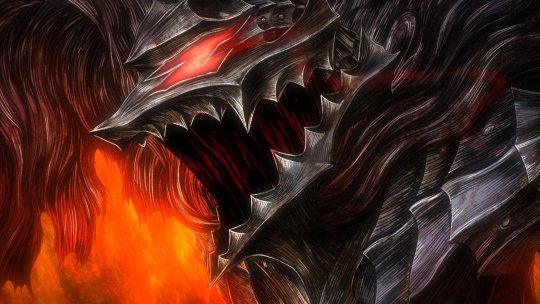
Miura said he sketched out most of the backstory when the manga began publication, so I have to assume the larger strokes of the Golden Arc were pretty well figured out from the outset, but I’m less sure if he had fully realized where he wanted to take the story to where we are now. After the introductory mini-arcs of demon-slaying, Berserk encounters Griffith and the story draws us back to a massive flashback arc. We see the same Guts living as a lone mercenary who Griffith persuades to join the Band of the Hawk to help realize his ambitions of rising above the circumstances of his birth to join the nobility.
We discover the horrific abuses of Guts’ adoptive father and eventually learn that Guts, Griffith, and Casca are all victims of sexual violence. The story develops into a sprawling semi-historical epic featuring politics and war, but the real narrative is in the growing companionship between Guts and the members of the band. Directionless and traumatized by his childhood, Guts slowly finds a purpose helping Griffith realize his dream and the courage to allow others to grow close to him.
Miura mentioned that many Band of the Hawk members were based on his early friend groups. Although he was always sparse with details about his personal life, he has spoken about how many of them referred to themselves as aspiring manga authors and how he felt an intense sense of competition, admitting that among them he may have been the only one seriously working toward that goal, desperately keeping ahead in his perceived race against them. It’s intriguing thinking about how much of this angst may have made it to the pages, as it's almost impossible not to imagine Miura put quite a bit of himself in Guts.
Perhaps this is why it feels so real and makes The Eclipse — the quintessential anime betrayal at the hands of Griffith — all the more heartbreaking. The raw violence and macabre imagery certainly helped. While Miura owed Hellraiser’s Cenobites much in the designs of the God Hand, his macabre portrayal of the Band of the Hawk’s eradication within the literal bowels of hell, the massive hand, the black sun, the Skull Knight, and even Miura’s page compositions have been endlessly referenced, copied, and outright plagiarized since.

The events were tragic in any context and I have heard many deeply personal experiences others drew from The Eclipse sympathizing with Guts, Casca, or even Griffith’s spiral driven by his perceived rejection by Guts. Mine were most closely aligned with the tragedy of Guts having overcome such painful circumstances to not only reject his own self enforced solitude, but to fearlessly express his affection for his loved ones.
The Golden Age was a methodical destruction of Guts’ self-destructive methods of preservation ruined in a single selfish act by his most trusted friend, leaving him once again alone and afraid of growing close to those around him. It ripped the romance of Guts’ mission and eventually took the story down a course I never expected. Berserk wasn’t a story of revenge but one of recovery.
Guess that’s enough beating around the bush, as I should talk about how this shift affected me personally. When I was young, when I began reading Berserk I found Guts’ unflagging stoicism to be really cool, not just aesthetically but in how I understood guys were supposed to be. I was slow to make friends during school and my rapidly gentrifying neighborhood had my friends' parents moving away faster than I could find new ones. At some point I think I became too afraid of putting myself out there anymore, risking rejection when even acceptance was so fleeting. It began to feel easier just to resign myself to solitude and pretend my circumstances were beyond my own power to correct.
Unfortunately, I became the stereotypical kid who ate alone during lunch break. Under the invisible expectations demanding I not display weakness, my loneliness was compounded by shame for feeling loneliness. My only recourse was to reveal none of those feelings and pretend the whole thing didn't bother me at all. Needless to say my attempts to cope probably fooled no one and only made things even worse, but I really didn’t know of any better way to handle my situation. I felt bad, I felt even worse about feeling bad and had been provided with zero tools to cope, much less even admit that I had a problem at all.
The arcs following the Golden Age completely changed my perspective. Guts had tragically, yet understandably, cut himself off from others to save himself from experiencing that trauma again and, in effect, denied himself any opportunity to allow himself to be happy again. As he began to meet other characters that attached themselves to him, between Rickert and Erica spending months waiting worried for his return, and even the slimmest hope to rescuing Casca began to seed itself into the story, I could only see Guts as a fool pursuing a grim and hopeless task rather than appreciating everything that he had managed to hold onto.
The same attributes that made Guts so compelling in the opening chapters were revealed as his true enemy. Griffith had committed an unforgivable act but Guts’ journey for revenge was one of self-inflicted pain and fear. The romanticism was gone.
Farnese’s inclusion in the Conviction arc was a revelation. Among the many brilliant aspects of her character, I identified with her simply for how she acted as a stand-in for myself as the reader: Plagued by self-doubt and fear, desperate to maintain her own stoic and uncompromising image, and resentful of her place in the world. She sees Guts’ fearlessness in the face of cosmic horror and believes she might be able to learn his confidence.

But in following Guts, Farnese instead finds a teacher in Casca. In taking care of her, Farnese develops a connection and is able to experience genuine sympathy that develops into a sense of responsibility. Caring for Casca allows Farnese to develop the courage she was lacking not out of reckless self-abandon but compassion.
I can’t exactly credit Berserk with turning my life around, but I feel that it genuinely helped crystallize within me a sense of growing doubts about my maladjusted high school days. My growing awareness of Guts' undeniable role in his own suffering forced me to admit my own role in mine and created a determination to take action to fix it rather than pretending enough stoicism might actually result in some sort of solution.
I visited the Berserk subreddit from time to time and always enjoyed the group's penchant for referring to all the members of the board as “fellow strugglers,” owing both to Skull Knight’s label for Guts and their own tongue-in-cheek humor at waiting through extended hiatuses. Only in retrospect did it feel truly fitting to me. Trying to avoid the pitfalls of Guts’ path is a constant struggle. Today I’m blessed with many good friends but still feel primal pangs of fear holding me back nearly every time I meet someone, the idea of telling others how much they mean to me or even sharing my thoughts and feelings about something I care about deeply as if each action will expose me to attack.
It’s taken time to pull myself away from the behaviors that were so deeply ingrained and it’s a journey where I’m not sure the work will ever be truly done, but witnessing Guts’ own slow progress has been a constant source of reassurance. My sense of admiration for Miura’s epic tale of a man allowing himself to let go after suffering such devastating circumstances brought my own humble problems and their way out into focus.
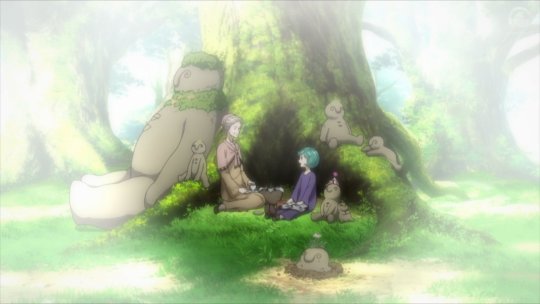
Over the years I, and many others, have been forced to come to terms with the fact that Berserk would likely never finish. The pattern of long, unexplained hiatuses and the solemn recognition that any of them could be the last is a familiar one. The double-edged sword of manga largely being works created by a single individual is that there is rarely anyone in a position to pick up the torch when the creator calls it quits. Takehiko Inoue’s Vagabond, Ai Yazawa’s Nana, and likely Yoshihiro Togashi’s Hunter X Hunter all frozen in indefinite hiatus, the publishers respectfully holding the door open should the creators ever decide to return, leaving it in a liminal space with no sense of conclusion for the fans except what we can make for ourselves.
The reason for Miura’s hiatuses was unclear. Fans liked to joke that he would take long breaks to play The Idolmaster, but Miura was also infamous for taking “breaks” spent minutely illustrating panels to his exacting artistic standard, creating a tumultuous release schedule during the wars featuring thousands of tiny soldiers all dressed in period-appropriate armor. If his health was becoming an issue, it’s uncommon that news would be shared with fans for most authors, much less one as private as Miura.
Even without delays, the story Miura was building just seemed to be getting too big. The scale continued to grow, his narrative ambition swelling even faster after 20 years of publication, the depth and breadth of his universe constantly expanding. The fan-dubbed “Millennium Falcon Arc” was massive, changing the landscape of Berserk from a low fantasy plagued by roaming demons to a high fantasy where godlike beings of sanity-defying size battled for control of the world. How could Guts even meet Griffith again? What might Casca want to do when her sanity returned? What are the origins of the Skull Knight? And would he do battle with the God Hand? There was too much left to happen and Miura’s art only grew more and more elaborate. It would take decades to resolve all this.
But it didn’t need to. I imagine we’ll never get a precise picture of the final years of Miura’s life leading up to his tragic passing. In the final chapters he released, it felt as if he had directed the story to some conclusion. The unfinished Fantasia arc finds Guts and his newfound band finding a way to finally restore Casca’s sanity and — although there is still unmistakably a boundary separating them — both seem resolute in finding a way to mend their shared wounds together.
One of the final chapters features Guts drinking around the campfire with the two other men of his group, Serpico and Roderick, as he entrusts the recovery of Casca to Schierke and Farnese. It's a scene that, in the original Band of the Hawk, would have found Guts brooding as his fellows engage in bluster. The tone of this conversation, however, is completely different. The three commiserate over how much has changed and the strength each has found in the companionship of the others. After everything that has happened, Guts declares that he is grateful.
The suicidal dedication to his quest for vengeance and dispassionate pragmatism that defined Guts in the earliest chapters is gone. Although they first appeared to be a source of strength as the Black Swordsman, he has learned that they rose from the fear of losing his friends again, from letting others close enough to harm him, and from having no other purpose without others. Whether or not Guts and Griffith were to ever meet again, Guts has rediscovered the strength to no longer carry his burdens alone.
All that has happened is all there will ever be. We too must be grateful.

Peter Fobian is an Associate Manager of Social Video at Crunchyroll, writer for Anime Academy and Anime in America, and an editor at Anime Feminist. You can follow him on Twitter @PeterFobian.
By: Peter Fobian
4 notes
·
View notes
Text
The visitor reaches observe

Top list manga should read prior to you pass away!
As machikado mazoku manga begins sort of steady the preliminary 3 amounts might lower a few of the site visitors in addition to the initial graphics isn't truly as much as the requirements these days's. Nonetheless, following the target market starts the Golden Age arc be hooked on the line and it's exceptionally difficult not to be absorbed. It's chock full of activity, theater, identity transforms, twists and development, as well as just a dashboard of love. It it is damn good as well as defies generalization narration.
But at that time the beat of the manga has actually changed. The audience has actually built a strong experience of Guts, Casca, as well as Griffith which just raises even more while the tale proceeds. You will be met with contrasting feelings and believe points such as "I truly desire to view Guts put Griffith inside the dirt" and in the exact same period "Griffith is simply so awesome". Feelings as well as these contradictory feelings simply check out show how spent the target market comes to be making use of individuals.
One more plus side to the machikado mazoku manga account is the reality that the character (Guts) isn't typically the main figure in every part. Infact, the majority of the important supporting cast members get a considerable amount of site area due to their very own reports to end up being fleshed out. All these side stories isn't quite possibly generated and simply unique, but likewise significant and exposing considering that it shows the audience why these identification are the direction they are. Among the side-stories that I found most exciting was Serpico as well as Farnese is given that it was wonderfully orchestrated included in the manga generally.
The sole issue in my own modest point of view, with all the history, could be the launch of secret inside the manga. I'm the marvel the party "gains" in size 24 is high as well as doesn't fit the dark setting of the tale. Actually, occasionally it may perhaps develop a number of the areas really feel a little shounen-esk. Yet actually nonetheless, it is practically impossible never to take advantage of the continuing story that's machikado mazoku manga.
Art - 9.6
The graphics within the initial a number of amounts of machikado mazoku manga wont do much to thrill lots of contemporary manga visitors, however at that time once the string was originally serialized (1992) it was most definitely well over standard. These original amounts include numerous extremely special character types (particularly the apostles) in addition to game a rather big concentrate on detail. Where Miura absolutely flaunts his surprise creative abilities in early stages is with his capability to produce sharp, really fluid, and clear fight scenes.
Amongst the read manga online bad areas of the very first checklists may be acknowledged as the easy therapy approaches that Miura utilized. Furthermore, in some cases the kind experiences will show up simply a little "off" plus maybe a little disruptive. These little top quality worries were possibly as a result of time constraints that have actually been set up during that time as opposed to totally the artist's mistake.
Then while the series proceeds the visitor reaches observe the art actually alter. Once we uncover even more as well as much more about the globe where they remain along with the figures, the numbers themselves in addition to their problems be increasingly more comprehensive. The easy treatment from your early listings is inevitably replaced with a hand therapy process gives an abrasive and also unique basic experience to the line. The character types be much more sharp and facial expressions occasionally are so magnificent that certain analyze a character's experience is usually sufficient to show the target market specifically what the personality is thinking. From the moment the target market beyond Miura has managed to get clear he method for machikado mazoku manga to end up being actually viewed as a point of elegance as much due to the fact that it is simply a well outstanding bit of storytelling and also makes it into lists 20.
Within my experience I've seen truly, extremely couple of various manga collection that may likewise come close to machikado mazoku mangais later volumes on an imaginative degree and also, unfortunately, I question that I'll actually have the capability to discover its peer.
People - 9.5
Most definitely not an incredibly innovative figure in the beginning look, however although he may start-off as a result, his personality ultimately winds up with each other of individual figures and also the really possible I've ever seen, and also conveniently increases.
With his past, you follow Guts while the tale unwinds, letting you encounter his personality adjustment throughout his continuous resist destiny. Intestines are followed by you via waves of struggles as well as despair balance out just from the flickering fires of self-confidence as well as friendship. the trouble arises, as well as ultimately, Guts becomes such as an uproar of contrary thoughts, can he carry on his route of most-consuming revenge although this implies shedding everything he's arrived at take care of?
An additional people that appear with the span of the tale can be located in sizes as well as numerous different shapes and also all perform their features entirely, in the same way assistance people should. Protagonists the vital solution figures and antagonists alike, are covered in several degrees of degree, developing attractive compounds inside the tale all together as well as their personalities similarly strong columns. The sustaining cast show their beauty in just how they might actually the target market as real individuals in machikado mazoku mangais great sport, and also not as easy story tools.
With this kind of actors of powerful people as well as energised, existing heroes, machikado mazoku manga just reduces it is method (no word play here meant) for the top ranking within this classification.
Complete satisfaction - 10
The reality I experience throughout 300 phases of this gorgeous anime manga in a solitary resting and lay should warrant the perfect rating for fun! The art matches the tale as well as is brooding black, and terrible. As well as what a fascinating tale it's ... It sets the factor for that most fascinating revenge influenced manga in the industry and also hooks you in the initial web page. My only problem may be the painful waits between areas.
There's a big amount nakedness, sex, gore, attack, and, for your absence of the far better term, negative-assery!
For other related details, you could also visit
https://bestlightnovels.site123.me/blog/the-artwork-is-breathtakingly
0 notes
Text
Killing some devil
A most prominent Japanese dark fantasy manga collection!
read manga online is an impressive manga with a badass main character. It's a dark story regarding shed, blood, hope, and worth of life. The very first 4 quantities, collectively called the Black Swordsman Arc, start as a simple vengeance story. Intestines, our major character was wrong, as well as he intends to correct that by viciously killing some devil or any asshole stands in his way.

But that sort of story is averted, as we are shown Guts's backstory, which right away transforms from a transgression tale to a story of betrayal, national politics, romance, constructing relationships, lasting hell, experience, securing the ones you hold dear, along with the mind of one of the most vital character.
Until the notorious Eclipse occurs. I will not ruin ANYTHING with this event yet are sufficient to state that following it, you relate to the lead character's Jerk-Ass facade a lot more, and also you also relate to the primary antagonist. And also the reasons that Midland is this kind of barbarous and also dark location to stay is revealed thoroughly.
Speaking about the detail, about the art work. Art in a manga plays similarly as considerable a function as the story, possibly much more so. The art in read manga online is outright amazing and remains a level of top quality throughout, which can be equally as striking as the high quality of the story.
The initial couple of volumes or so show information as well as capability, however the grade isn't as much as the succeeding chapters. Which is what makes read manga online even more of a joy to see, as Miura intends to show that he wants read manga online not to just be remembered by its impressive story, however he needs it to be taken into consideration a work of art.
As the art work design boosts, we see the quality of the art work improve and also better. It is really in-depth, as well as small items like mild hand shading, personality expressions, usage of ink artistically to simulate spurting, gushing blood, and also these make the art a work of art of pencil as well as ink style.
Regarding the pashiri na boku to koi suru banchousan characters, every single character is profound as well as achieved, relatable, as well as likable. Hell, even the bad guys are hefty and relatable, although that they do awful features. No question extensive personalities are assisted by the caliber of the story, yet each personality you can relate to, and origin.
Guts are amongst the strangest, most complex lead characters which exist. His flaws, he makes blunders, he is effective and also needless to say, a badass, and extremely prone to remarkable moments. Said awesome moments are not always combating scenes, sometimes they are discussions with different personalities, phases dedicated to his mind. All of these produce Guts a remarkable character.
The villains are heavy as well as distinct, which enhances the total intrigue of the story. The most essential villain becomes special reference because they're shown either side of this coin. You obtain scenes in which they're an excellent as well as decent individual, after that you get scenes such as the well-known Eclipse. The personalities simply increase the storyline and make it a lot more believable.
Generally, it's a superior manga with amazing art work, outstanding story, interesting personalities all finish to create a manga online free that's a must-read, also when you are not right into manga, simply give it a shot.
Other details can be accessed at
https://jocelynhonore.doodlekit.com/blog/entry/12888535/it-totally-in-different-ways
0 notes
Text
Every one of these develop

A most popular Japanese dark fantasy manga series!
monku no tsukeyou ga nai rabukome manga is an impressive manga with a badass major personality. It's a dark tale about lost, blood, hope, as well as worth of life. The very first 4 quantities, collectively called the Black Swordsman Arc, start as a straightforward vengeance story. Digestive tracts, our major character was incorrect, as well as he means to rectify that by viciously killing some satanic force or any kind of asshole stands in his method.
Yet that sort of narrative is averted, as we are shown Guts's backstory, which instantly transforms from a transgression tale to a narrative of dishonesty, politics, romance, developing friendships, lasting hell, experience, protecting the ones you hold dear, along with the mind of one of the most vital personality.
Till the well-known Eclipse occurs. I will not ruin ANYTHING with this event but are enough to claim that following it, you associate with the protagonist's Jerk-Ass facade much more, as well as you also associate with the principal villain. As well as the reasons why Midland is this sort of barbarous and also dark location to reside is revealed carefully.
Discussing the information, concerning the artwork. Art in a manga plays equally as considerable a feature as the story, perhaps much more so. The art in monku no tsukeyou ga nai rabukome manga is outright fantastic and also stays a degree of quality throughout, which can be equally as striking as the top quality of the story.
The first few quantities approximately reveal detail and also capability, yet the quality isn't as much as the succeeding chapters. And that is what makes monku no tsukeyou ga nai rabukome manga much more of a happiness to see, as Miura plans to show that he wants monku no tsukeyou ga nai rabukome manga not to just be remembered by its impressive story, yet he requires it to be taken into consideration a work of art.
As the artwork style enhances, we see the quality of the artwork get better and also better. It is very thorough, and also small things like mild hand shading, personality expressions, usage of ink artistically to simulate shooting, spurting blood, as well as these make the art a work of art of pencil and ink design.
Regarding the her appetites too big for me alone characters, every personality is profound as well as established, relatable, and nice. Heck, even the villains are heavy and also relatable, despite the fact that they do terrible features. No doubt profound personalities are aided by the caliber of the storyline, but each personality you can connect to, and also origin.
Intestines are among the strangest, most complex protagonists which exist. His defects, he makes mistakes, he is effective as well as it goes without saying, a badass, and also very prone to impressive minutes. Said incredible moments are not constantly combating scenes, in some cases they are discussions with various personalities, phases dedicated to his mind. Every one of these develop Guts an amazing personality.
The bad guys are heavy as well as distinct, which increases the overall intrigue of the storyline. The most vital antagonist ends up being special reference since they're revealed either side of this coin. You obtain scenes in which they're a good as well as suitable person, then you get scenes such as the infamous Eclipse. The personalities just enhance the storyline and also make it more believable.
In general, it's an impressive manga with exceptional art work, remarkable story, interesting personalities all culminate to produce a manga online complimentary that's a must-read, even when you are not right into manga, just offer it a shot.
You may also visit
https://japanesemangaguideblog.wordpress.com/2021/02/27/20nn2s4r03rgoz4c8u5nzg1614492380/
for more related info
0 notes
Text
Tale of a finest swordsman

Considering that Sozai Saishuka No Isekai Ryokouki begins type of steady a number of the followers may reduce in addition to the initial art isn't really upto the needs these days's. Nonetheless, complying with the visitor begins the Golden Age arc be dependent on the line and also it's extremely difficult not to be absorbed. It's chockfull of activity, theatre, identification spins, growth and also turns, as well as simply a dashboard of connection. It it is damn good as well as opposes generalization storytelling.
Yet at that time the circulation of the manga has actually changed. The target market has actually created a strong experience of Guts, Casca, and Griffith which simply increases much more due to the fact that the story proceeds. You will certainly be challenged by contrasting sensations as well as think points such as "I absolutely wish to watch Guts set Griffith within the soil" as well as in the same period "Griffith is merely so amazing". Ideas and also these inconsistent sensations just head to demonstrate just how invested the audience comes to be using the people.
Another benefit of the Sozai Saishuka No Isekai Ryokouki history is the reality that the personality (Guts) isn't generally the primary figure in every component. Infact, nearly all of the main supporting cast participants obtain a considerable quantity of site area because of their very own reports to become fleshed out. All these side-stories because it shows the target market why these identification are the direction they are isn't just unique and well produced, but likewise strong and exposing. One of lots of side-stories that I discovered most exciting was Serpico and also Farnese is since it was beautifully orchestrated consisted of in the manga generally.
The single trouble in my own humble point of view, with all the account, will be the release of secret inside the manga. I'm the secret the class "receives" in dimension 24 is high as well as doesn't fit the dark setting of the tale. In fact, sometimes it could in fact produce several of the sections really feel a little shounen-esk. But really nevertheless, it is basically difficult to not gain from the continuing tale that's Sozai Saishuka No Isekai Ryokouki.
Art - 9.6
The graphics within the very first several lists of Sozai Saishuka No Isekai Ryokouki will refrain much to thrill lots of modern manga viewers, however while once the collection was initially serialized (1992) it was undoubtedly well over standard. These initial quantities include a number of very unique character kinds (specifically the apostles) along with video game a rather big concentrate on information. Where Miura really displays his surprise imaginative abilities at first is with his ability to generate sharp, remarkably fluid, as well as clear battle scenes.
Amongst the Infection bad locations of the very first checklists may be defined as the easy treatment methods that Miura used. In addition, occasionally the kind looks can look just a little "off" plus it can be rather a little disruptive. These very little top quality issues were almost certainly as an outcome of time limitations that have been in placement while instead of exclusively the musician's blunder.
Then whilst the series developments the viewer reaches view the art actually alter. Once we learn far more and also much more about the world where they remain along with the heroes, the heroes themselves along with their scenarios be a lot more and a lot more in-depth. The easy therapy from your early lists is eventually replaced with a hand covering procedure which provides an even unique and also sandy basic experience to the collection. The personality patterns be tidy as well as faces occasionally are so brilliant this set check out a character's experience is frequently sufficient to notify the target market exactly what the personality is assuming. From the moment the target market past Miura has procured clear he approach for Sozai Saishuka No Isekai Ryokouki to end up being really seen as a masterpiece of style similarly as much since it can be a well impressive little bit of narration and also makes it right into checklists 20.
Within my experience I've seen really, very few various manga series that will certainly likewise come close to Sozai Saishuka No Isekai Ryokoukiis later quantities on a creative level and, sadly, I doubt that I'll actually manage to locate its peer.
Individuals - 9.5
Definitely not an incredibly dynamic number in the beginning glance, however although he may start-off therefore, his character ultimately winds up as you of the extremely reliable and private individuals I've ever before seen, and also quickly grows.
Via his past, you follow Guts since the story relaxes, enabling you to encounter his personality change throughout his consistent struggle against destiny. Guts are complied with by you via waves of battles and misery offset only from the flickering fires of self-confidence and also relationship. the concern arises, in addition to eventually, Guts becomes such as a maelstrom of various other ideas, may he carry on his training course of most-consuming revenge also when this suggests shedding whatever he's arrived at deal with?
One other individuals that appear with the span of the history can be discovered in all and sizes and also various different forms do their functions properly, similar to assistance people should. Villains, lead characters and also the considerable service figures alike, are covered in a number of levels of degree, producing amazing aspects inside the piece entirely and also their characters similarly solid columns. The dedicated actors show their style in exactly how they may really the audience as real participants in Sozai Saishuka No Isekai Ryokoukiis awesome sport, and also not merely as easy story devices.
With this type of cast of effective individuals as well as lively, existing people, Sozai Saishuka No Isekai Ryokouki merely decreases it is strategy (no pun planned) in the direction of the leading position within this group.
Afterall - 10
The reality that I check out all 363 chapters of this fantastic anime manga in a solitary resting and also lay must warrant the suitable score for enjoyable! The art is terrible, brooding, and also black and matches the tale. And also what a remarkable tale it's ... It sets the level for your most fascinating revenge inspired manga out there as well as hooks you from your first section. My only problem will certainly be the agonizing waits in between sections.
For further details, go here:
https://greatpaintingservicespostblog.wordpress.com/2019/10/08/5hww2wrt7y3h7l1wwaiag1570529633/
0 notes